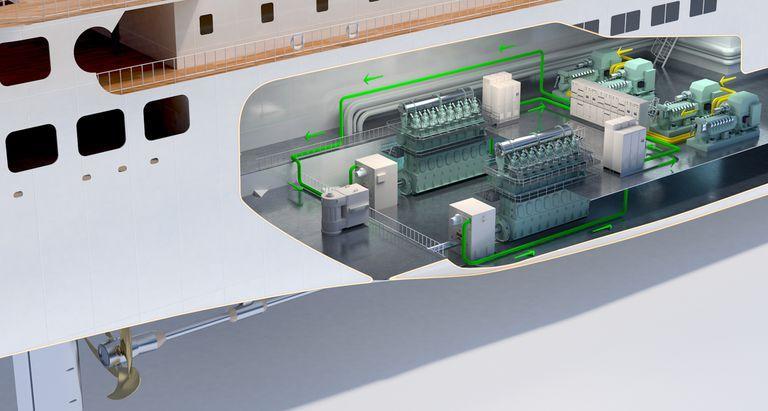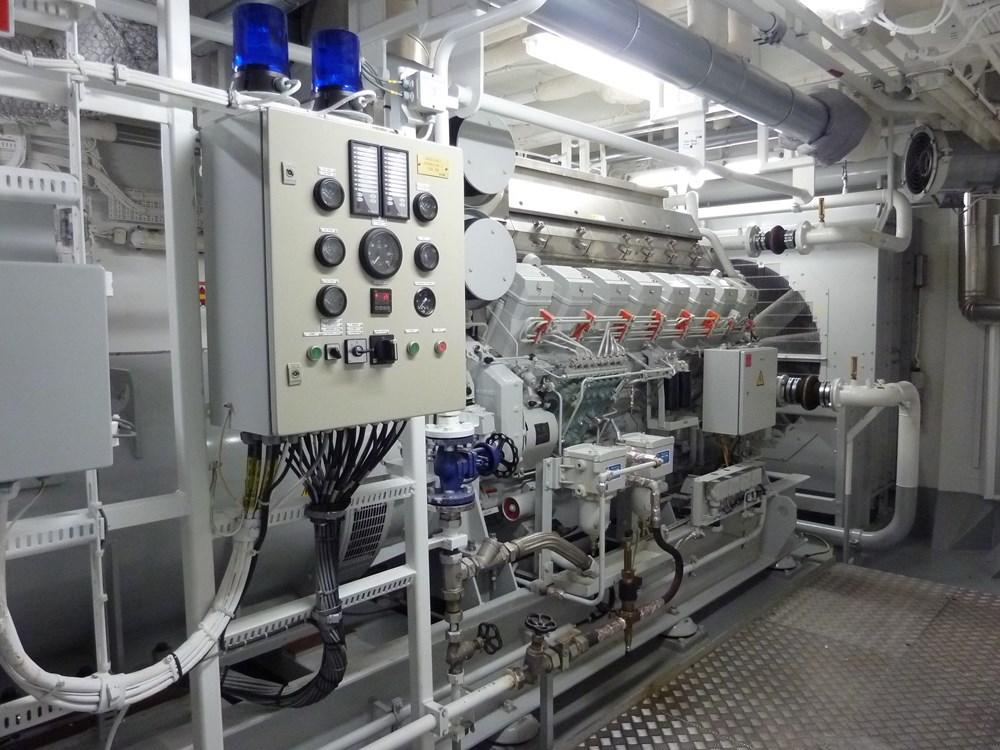Table Of Content

Should they also fail, vessels are required to have a battery backup. 24 hours of power are at least provided by battery rooms to the smaller emergency equipment list. A 4 stroke engine can be installed on the ship to produce electrical power and also to propel the ship (usually in small size vessel). This engine takes 4 cycles to complete the transfer of power from the combustion chamber to the crankshaft.
Ballast Tanks
Engine room explosion reported on Maine cruise ship - WorkBoat
Engine room explosion reported on Maine cruise ship.
Posted: Wed, 25 Oct 2023 07:00:00 GMT [source]
Big ships require much power, so they might have more than one emergency generator. Despite that, they don't have the capacity of main generators and engines, don't produce electricity enough to move the ship, and can't supply all the power needed in ports, because of constraints in space. The ambition in the cruise industry is to go above and beyond – to exceed expectations. This is as true for the guest experience as it is for the industry’s drive to reduce emissions and decarbonise. When the goal is net zero operations, cruise ships need a range of sustainable engines, propulsion solutions, maritime technology, and services. Emissions from cruise ship engines contribute to air pollution and climate change.
Can Passengers Explore the Hull?
This might require skipping planned ports so the ship can make it to its final port on time. If the engine failure is short-lived and the ship's crew are able to restore power again quickly, the captain might make the decision to continue with the ship's itinerary, as planned. Passengers can be proactive in keeping themselves safe as well by attending -- and paying attention to -- the cruise ship's mandatory safety exercise, called the muster drill.
How Big Is a Cruise Ship Engine?
ABB supplied the vessel's power and electric propulsion systems, as well as the Octopus (smart energy management system). While mechanical propulsion is optimized for a single-speed, electric propulsion is based on rotating speed control resulting in energy efficiency at all speeds. ABB's propulsion also improves passenger comfort as the ship runs much more quietly and smoothly. ABB's Octopus marine technology allows real-time monitoring of the vessel's energy (and fuel) consumption. Based on the collected data, the software suggests optimal performance recommendations.
Icon of the Seas Engines Started for the First Time
These regulations outline limits for the emission of sulfur oxides, nitrogen oxides, and particulate matter from ships operating in designated emission control areas. In addition to propulsion, the power requirements for onboard facilities and amenities must also be taken into account. Cruise ships have a wide range of facilities, including restaurants, bars, entertainment venues, spas, and more. These facilities require electricity and other energy sources to operate smoothly. The engine must have the capacity to generate sufficient electricity to meet these demands. This durable material is required to withstand the immense pressure and stress of traveling through oceans and large seas.
The ships can burn both liquified natural gas and marine fuel, reducing the required fuel storage space. Battery power is used during turnaround navigation in ports when the onboard diesel-electric generators are switched off. As of 2019, Corvus Energy delivered its innovative product line "Orca ESS" to 200+ vessel conversion/upgrade projects, totaling 200+ MWh. Those who support the cruise industry point out that cruising has never been more popular.
Cruise Ship Fuel Consumption
AIDAprima (2016) is one of the world's most technologically advanced cruise vessels. The ship rides on a cushion of air, thus reducing frictions and fuel consumption, The new technology is called MALS ("Mitsubishi Air Lubrication System"), allowing the liner to glide on an air bubbles carpet. When cooled to -160 C, it passes from gas to liquid, and its volume decreases over 600 times, making it very efficient for distribution. Short-distance LNG transportation is via trucks or smaller vessels (also barges) fitted with high-pressure tanks.
Despite innovations in engine technology, cruise ships produce a lot of pollution. Natural gas is purer, cleaner, more efficient, and cheaper than other fossil fuels. But it’s a relatively new technology, and not all ports have the facilities for refueling LNG-powered ships.

Even if you choose to stay in one of the most expensive suites on the ship, this doesn’t guarantee that you’ll be able to rest undisturbed. There are plenty of other things that could keep you awake at night on a cruise ship. Staying in one of these cabins means that you will likely be exposed to plenty of noise and vibrations from the engine.
These certifications ensure that the engines meet essential safety requirements and undergo regular inspections and audits. Engines with high fuel efficiency can significantly improve the cruising range of a ship, enabling longer journeys without the need for frequent refueling. This is especially important for cruise itineraries that cover long distances or involve remote destinations where refueling options may be limited. If, for example, passengers wandered into the engine room unsupervised, the results could be catastrophic. Numerous machines and pieces of equipment are essential to the entire ship’s safe operation down in the hull, so it needs to be protected. This is because the hull can be hazardous for those needing the proper training and expertise.
Each ship is fitted with two battery packs (combined capacity 316 kWh / 563 HP output). The electricity is provided by 2 fully-independent power systems and split evenly between the 2 hulls. TUI published the company's environmental impact report (first of its kind) including environmental objectives and TUI strategy for a 5-years period. According to it, in 2012 TUI reduced by 3.7% per nautical mile its fuel consumption, and expects further 5% reduction, reducing CO2 emission at the same time by 0.5 kg to 0.55 kg per traveler. For most vessels, the average consumption is miles on a fuel gallon.
The electricity they produce is sent to electric motors, which then power and turn the propellers. Often, there are many comparatively smaller engines that make up the power demand for the ship; in port, only one engine may be online, but out at sea at full speed, they may all be online. On some vessels, power for one of the fuel oil supply pumps, booster pumps and starting air compressors are also supplied from the emergency SB. Output shafts are used to generate electrical power and are connected to the generators.
The 3rd Oasis-class ship - Harmony of the Seas, is currently the most technologically advanced and energy-efficient cruise vessel ever built. As technology continues to advance, further improvements are being made in the efficiency and energy storage capabilities of hybrid electric systems. This, coupled with ongoing advancements in battery technology, will pave the way for even more efficient and environmentally friendly cruise ship operations in the future. While COGAS systems offer numerous advantages, they do require regular maintenance and expertise to ensure optimal performance. The integration of gas and steam turbines requires careful monitoring and control to maintain the balance between power generation and fuel efficiency. Diesel engines are the most commonly used type of engines in cruise ships due to their efficiency and reliability.
While it may look seamless from the outside of the ship, the hull of a cruise ship is made up of several segments that all serve a unique function. Since there is so much space available in the hull of a cruise ship, it is a good location for various storage compartments and refrigeration rooms. Depending on the ship’s needs, these storage areas can be used to store everything from food and beverages to medical supplies and bedding. A significant amount of the ship’s fuel will also be stored in the hull.
While gas turbine engines offer several advantages, they also have some considerations to take into account, such as higher fuel consumption at lower speeds and the need for regular maintenance. However, ongoing advancements in gas turbine technology continue to improve their efficiency, reliability, and environmental performance. It provides a physical structure for the ship to be built upon and the buoyancy required to keep the cruise ship and everything it is carrying afloat. The hull also helps reduce water resistance, which helps with everything from improving fuel efficiency to allowing the ship to travel through the water smoother and faster. The regulations require full redundancies -- including two engine rooms and the doubling up of cables and electrical systems that snake throughout ships.
Large equipment (propulsion motor, bow thrusters) requires electricity of high voltage. As for smaller machinery (cabin lights, galley equipment), the electricity goes through the transformer and is thus stepped down into lower voltage. Large cables snake through all the ships to distribute electrical power. They carry power from generators to switchboards, through passageways, public rooms, crew and passenger cabins. If the electrical cables aren't truly redundant, even ships that feature two engine rooms suffer power failure. Main engines and generators require electricity and it's needed to keep them going.
No comments:
Post a Comment